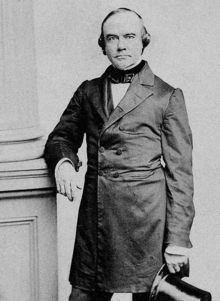
Back بنيامين روبنز كورتيس Arabic بنيامين روبنز كورتيس ARZ بنجامین روبینز کورتیس AZB বেঞ্জামিন রবিন্স কার্টিস Bengali/Bangla Benjamin Robbins Curtis German בנג'מין רובינס קרטיס HE Benjamin Robbins Curtis ID Benjamin Robbins Curtis Swedish
Benjamin Robbins Curtis | |
|---|---|
 | |
| Associate Justice of the Supreme Court of the United States | |
| In office October 10, 1851 – September 30, 1857 | |
| Nominated by | Millard Fillmore |
| Preceded by | Levi Woodbury |
| Succeeded by | Nathan Clifford |
| Personal details | |
| Born | November 4, 1809 Watertown, Massachusetts, U.S. |
| Died | September 15, 1874 (aged 64) Newport, Rhode Island, U.S. |
| Political party |
|
| Spouses | Eliza Woodward
(m. 1833; died 1844)Anna Scolley
(m. 1846; died 1860)Maria Allen (m. 1861) |
| Children | 12 |
| Education | Harvard University (BA, LLB) |
Benjamin Robbins Curtis (November 4, 1809 – September 15, 1874) was an American lawyer and judge who served as an associate justice of the United States Supreme Court from 1851 to 1857. Curtis was the first and only Whig justice of the Supreme Court, and he was the first Supreme Court justice to have a formal law degree. He is often remembered as one of the two dissenters in the Supreme Court's infamous 1857 decision Dred Scott v. Sandford.[2]
Curtis resigned from the Supreme Court in 1857 to return to private legal practice in Boston, Massachusetts. In 1868, Curtis was President Andrew Johnson's defense lawyer during Johnson's impeachment trial.
- ^ Forret, Jeff (2012). Slavery in the United States. Infobase Publishing. p. 369. Archived September 14, 2021, at the Wayback Machine.
- ^ "Famous Dissents – Dred Scott v. Sandford (1857)". PBS. Archived from the original on September 5, 2012. Retrieved August 20, 2012.